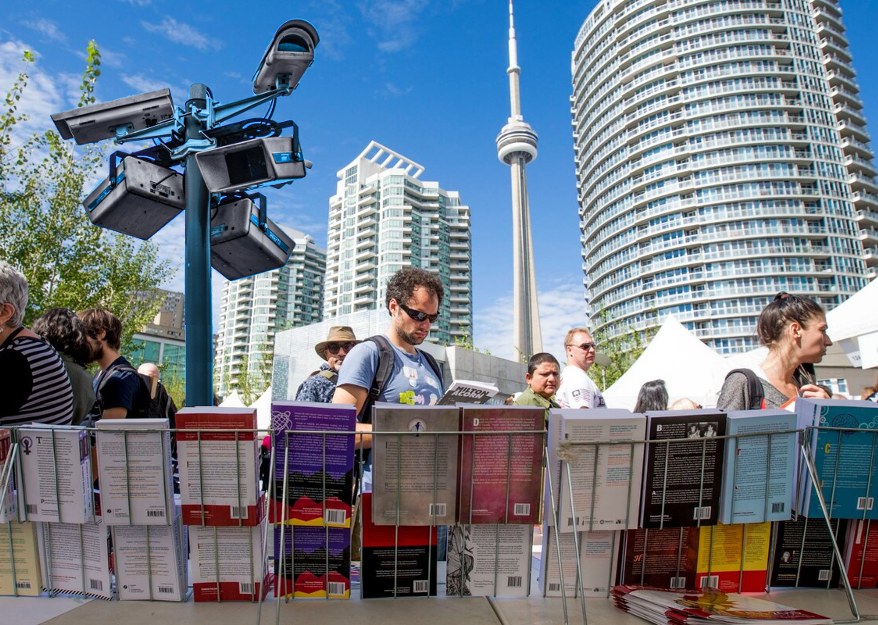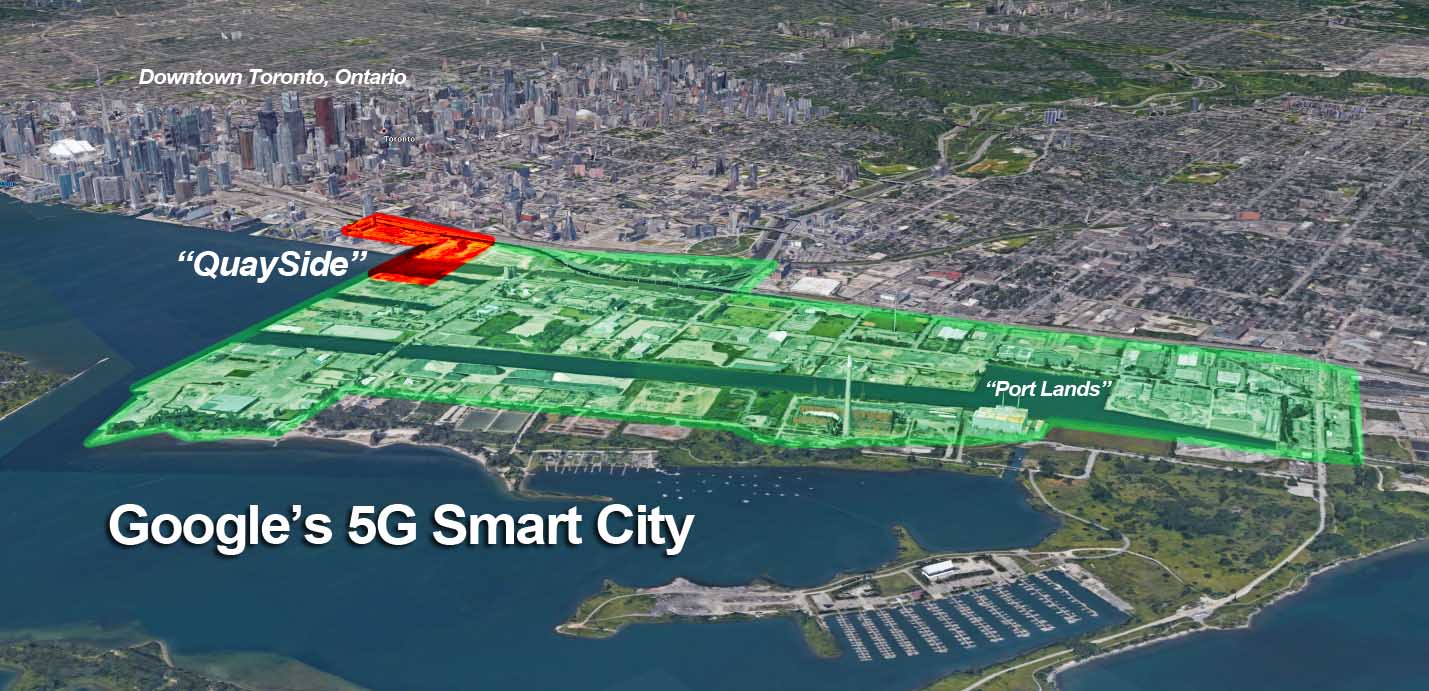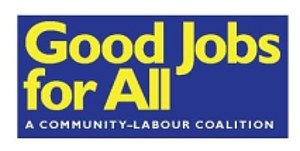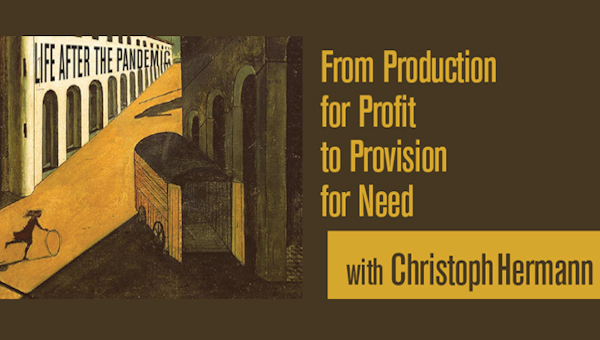Covid-19, Google, and the future of Toronto’s Waterfront
Waterfront Toronto is a tri-government agency with a mandate to re-develop the waterfront. In its search for a ‘funding and development’ partner it has been effectively captured by Google’s digital urbanism agenda and the potential revenue stream from the development, use and sale of ‘smart city’ technologies. Sidewalk Labs is a Google sister company with grandiose plans to develop hundreds of acres of Toronto’s waterfront to which it has no title. The land, data, and power grab behind this ‘Googleopolis’ has met with growing opposition. In response to that criticism, Waterfront Toronto has scaled back the plan to the original twelve acre site known as Quayside, essentially as the preliminary staging ground for the wider vision Google still wants to pursue. A number of Sidewalk Labs digital innovations and urban space proposals would lay the groundwork for future waterfront development that would begin with Quayside.
The proposals were packaged and presented for a round of public input which ended on April 9, 2020. Waterfront Toronto’s Board of Directors is scheduled to make a final decision on the project by June 25, 2020. For further background on Google’s plans see the earlier Bullet “Ten Reasons to Say No.”
In February 2020, Waterfront Toronto announced a second round of public consultations on Waterfront Toronto’s Master Innovation and Development plan (MIDP) evaluation and the development plans for Quayside. Waterfront Toronto has published a Discussion Guide and has issued the report of the Quayside Evaluation Committee and it has identified 144 Sidewalk Labs initiatives that it proposes to include in the new Innovation Plan for Quayside. This is our response to the request for public input. But we draft it in the midst of a COVID 19 pandemic that has disrupted normal life, presents unprecedented challenges to our healthcare system and whose far-reaching fallout in social and economic terms is only now beginning to be glimpsed.
The post-COVID city will need to be different in some fundamental respects than what existed before the crisis. The Coronavirus is focusing attention on social inequities in a most dramatic way. At the same time, we see that government can act deliberately and decisively when there is a will to do so.
Antonio Gutierrez, Secretary General of the UN has recently concluded: “The pandemic has reminded us, in the starkest way possible, of the price we pay for weaknesses in heath systems, social protections and public services.”
 Waterfront’s Quayside project will be built in a post-COVID world, a world struggling to recover from the grip of a major health, social and economic crisis. The Evaluation Committee Report described its recommendations and conclusions as a “moment in time “assessment. That “moment in time” has now been inexorably disrupted. The discussions we are having today about Quayside tomorrow need to be framed against that background. The Post-COVID city may look different than the Smart City economic aspirations of Big Tech. Priority may shift from technical innovations and nice to have do-dads to more fundamental issues of equity, integrated communities, sustainability, social protections and public services. Quayside as a 1public project, (of three levels of government), takes on a new role as one of the first post-COVID urban developments. The lessons we are learning now will need to be built into the very fabric of that community.
Waterfront’s Quayside project will be built in a post-COVID world, a world struggling to recover from the grip of a major health, social and economic crisis. The Evaluation Committee Report described its recommendations and conclusions as a “moment in time “assessment. That “moment in time” has now been inexorably disrupted. The discussions we are having today about Quayside tomorrow need to be framed against that background. The Post-COVID city may look different than the Smart City economic aspirations of Big Tech. Priority may shift from technical innovations and nice to have do-dads to more fundamental issues of equity, integrated communities, sustainability, social protections and public services. Quayside as a 1public project, (of three levels of government), takes on a new role as one of the first post-COVID urban developments. The lessons we are learning now will need to be built into the very fabric of that community.
The COVID 19 pandemic has reinforced many of the Good Jobs for All previously stated concerns with the Quayside project. And it has strengthened our view that the quayside project should be focused on good jobs, affordable housing, the smart use of public spending, equitable and sustainable communities, robust privacy protections and digital safeguards and the advancement of public services and democratic oversight.
The current Quayside plan fails to adequately address these issues. Our assessment of the 144 proposals that Waterfront has decided to include in the Innovation Plan suggests that they fail to achieve the objectives that Waterfront Toronto has identified for Quayside. Our evaluation of the role Waterfront Toronto is playing as both the developer and the evaluator of its own plan points to a conflict of interest that undermines confidence in Waterfront Toronto’s ability to effectively represent the public interest. The composition of the Quayside Evaluation Committee – three Waterfront Toronto executives, two consultant insiders and one independent outsider – reinforces this concern.
Good Jobs
There is expected to be about 4500 residents at Quayside. A lot is known about how those residents will live. Through proposals we are told about the units they will live in, what their neighbourhood will be like, and how their environment will be built. We are told about the size of their apartments, their waste disposal system, their thermostats, the lighting in their buildings, even the design of some of their furniture. We know details about the streets they will walk down, the services they will be provided, their likelihood to own a car, and on and on.
But when it comes to a discussion of jobs the commentary is much different. Quayside, we are told, is expected “to host 3900 jobs.” Even the choice of the word ‘host’ is revealing in its hands-off characterization of one of the most important aspects of a community’s life – what jobs people get. But we know virtually nothing about their workplaces, their incomes nor the jobs they will have.
The MIDP (Master Innovation Development Plan), Sidewalk Lab’s sprawling 1500-page report had very little to say about jobs. We are no further ahead in Waterfront Toronto’s new iteration of some of Sidewalk Labs ideas. If anything, the Evaluation Report has shifted the discussion about jobs to a more abstract level in its recommendation to focus more on “wealth creation” and attracting “talent and human capital” to the city.
Job creation is one of the priority objectives that Waterfront Toronto has articulated for the Quayside project. But there are no job targets in the report, no actual plans for purposeful job creation and no discussion about the terms and conditions of employment. Outside of the projected construction jobs, there is very little discussion about what jobs will be created. The job numbers that are used are very imprecise based as they are on statistical calculations and mathematical estimates about the ratio of jobs to the square footage of retail and commercial space.
Why does it matter? Because a clearly stated goal of the project is to build a complete community that is diverse, accessible and inclusive. That won’t happen without a fuller understanding and a different perspective on jobs. It won’t happen unless there is a public policy intervention that consciously attempts to break the pattern, in which women and racialized workers are overrepresented in precarious, low wage jobs and where indigenous and disabled workers are virtually excluded from employment.
In the absence of an active job strategy we can predict a business as usual job scenario at Quayside:
- A large number of workers in precarious employment – irregular hours and low pay in the retail, food, accommodation and hospitality,
- A growing number of precarious, gig economy workers in the technology-enabled sector such as food and parcel delivery and ride hailing,’
- A declining number of workers in the public sector as services are privatized or automated, such as the proposed waste management system.
- A mixed bag of jobs in the Big Tech sector where temps, vendors and contractors (TVCs) will outnumber higher-paid permanent jobs and on the margins the long hours and low pay associated with start-ups and many self-employment initiatives.
If the large majority of residential units at Quayside are priced at market rates, as is the plan, then this pattern of employment will be exaggerated by a class divide of relatively well-to-do residents who live in the neighbourhood and a daily influx of workers, who can’t afford to live in the area, but commute into the area for jobs.
As part of its evolving approach to digitally enabled innovations Waterfront Toronto is establishing a set of “intelligent community guidelines” which will govern the behaviour of all companies involved in technology-enabled projects at Quayside. There should be a parallel development around jobs. Waterfront Toronto, in consultation with labour and community groups, should establish an “Employer code of conduct” for Quayside area employers which would include a commitment to a liveable wage, stabilized work hours, real career paths and employer neutrality should workers decide to form a union.
All workers deserve decent jobs, where they are treated with respect and dignity paid a living wage and where there is a measure of security. If Waterfront Toronto is serious in its commitments to build a diverse and inclusive community at Quayside a much different 3approach to jobs is required. Neither Sidewalk Lab’s plans nor the 144 initiatives proposed for the Waterfront Toronto Innovation Plan will achieve that goal. In helping to build a post-COVID city Waterfront Toronto should acknowledge and actively promote the rights of workers. That would be a different starting point.
Affordable Housing
Toronto is one of the most multicultural and multiracial cities in the world. We are diverse but not inclusive and definitely not equal. That inequality is drawn in sharp relief when it comes to housing. And the current pandemic has made the situation even more acute. ACORN Canada has pointed to the precarious choice too many Toronto residents are now forced to make between food and rent.
In its public discussion guide Waterfront Toronto notes that “currently there are more than 100,000 households on the waiting list for affordable housing in Toronto” admittedly there is only so much Waterfront Toronto can do about such a massive problem in a relatively small development at Quayside. But it can do more than it proposes.
A recurring concern, expressed in public consultations, is the need for more affordable housing than proposed by Sidewalk Labs. Those oft-repeated concerns have been ignored.
Waterfront Toronto’s current plan for Quayside fails on affordable housing in four significant ways. First, by supporting Sidewalk Lab’s efforts to shift the ratio of residential to commercial units in favour of the latter – more retail and office units. Second, by setting the bar too low for affordable housing units as a share of overall residential units. Third, by setting rents too high and beyond the means of most families who are in need of affordable housing. And fourth, by failing to identify and commit the substantial funds that are required to actually achieve the affordable housing goals.
Sidewalk labs has proposed to increase the amount of retail and commercial space as a per cent of the overall build when compared to existing City Precinct Plans. The precinct plan calls for a mix of 75% residential and 25% commercial units. Sidewalk Labs proposes a 66% residential to 33% commercial split. The difference is considerable. It amounts to forfeiting over 900,000 square feet of residential space in Quayside. That is a lot of rental units. Since affordable housing units are calculated as a percentage of all residential units then when fewer residential units are built, fewer affordable units will be built. According to the MIDP “Sidewalk Labs’ development plan proposes over six times the amount of non-residential space required in Quayside.” Waterfront Toronto has supported this move.
In the original RFP Waterfront Toronto expressed its intention that the successful bidder would provide more than the minimum 20% requirement for affordable housing. Sidewalk Labs won the tender but failed to propose more than the 20%. In the current plan the 20% minimum is now regarded as the actual goal. (According to Waterfront staff the figure is now closer to 24% because of the transfer of commitments that weren’t achieved on a different project.) Our calculations here are based on the 20% figure that is reported in the official Discussion Guide. At 20% there will be about 530 units in the affordable housing program at Quayside. That figure should be increased by shifting the ratio of commercial u its to residential units and by substantially increasing the 20%.
Even though about 530 units are identified as affordable, few of them will actually be affordable. According to Waterfront Toronto, the breakdown of the units is as follows: The 20% is made up of two categories of affordability. Fifteen per cent of the overall residential units will be available at 90% of the Average Market Rent (AMR) and 5% will be offered at 40% AMR. The figure for the AMR used by Sidewalk Labs in its report was $1492 month for a two-bedroom apartment. At 90% AMR that amounts to $1343 a month or over $16,000 a year. Using the established guideline of 30% of income on rent suggests a family would need an annual income of $54,000 to afford the rent on such a unit. The majority of renter households are unable to afford that level of rent.
Where Waterfront Toronto has made an improvement over Sidewalk Labs plan is in the category of ‘deep affordability’. Sidewalk Labs proposed that the 5% of units in this category be available at 65% of AMR. Waterfront Toronto has changed that to 40% of AMR. These units will be affordable.
Unfortunately, there will only be about 130 apartments available at the ‘deeply affordable’ rate. That represents just over 1/10 of 1% of those 100,000 households identified by Waterfront Toronto as needing affordable housing. It has been estimated that the public land at Quayside is worth over $590-million. Surely with such a significant public asset Waterfront Toronto could achieve more than 130 affordable apartments.
Employment Initiative
In the section of the Public Discussion guide called ‘Building Complete Communities’ Waterfront Toronto notes its support for an employment initiative that allocates 10% of construction hours to equity seeking groups. This is one of the 144 proposals that Waterfront Toronto will include in its the New Innovation Plan and is in line with the already existing Waterfront Toronto Employment Initiative. The figure of 10% is quite low when the numbers are calculated. Here’s the arithmetic:
Sidewalk Labs has estimated that to build all of the buildings in the 12-acre Quayside area will require about 5,000 person years of direct construction. Ten per cent of that is 500 person years. Translated into full year equivalents that means only100 full-year jobs for only five years for historically disadvantaged groups. Seen in this light the 10% commitment is inadequate and should be considerably higher. In the absence of clear provisions on monitoring and enforcement and other aspects of contract compliance, it is unlikely that even the low target of 510% will be achieved. A critical concern that has been noted on current Waterfront Toronto projects and other developments around the city.
Digital Solutions and Data Privacy
One of the most contentious issues surrounding the development on the waterfront was Sidewalk Labs’ cavalier and crass commercialist approach to the collection and use of personal data. In the Threshold Agreement of Oct 31, 2019 Waterfront Toronto tried to undue some of that damage by slapping Sidewalk Labs on the wrist and claiming that, “Waterfront Toronto, with its government stakeholders, will take the lead on data governance.”
Waterfront Toronto also indicated that Sidewalk Labs would release an updated Digital Innovation Appendix that, in addition to providing a mass of technical details, would clarify the company’s approach to technology enabled initiatives and digitally driven innovation. (That 483-page report was released on Nov. 15, 2019).
In the Digital Innovation Appendix Sidewalk Labs now appears to say all the right things. It talks about an approach to innovation that is characterized by “digital restraint.” It commits to “data minimization, security, and de-identification by default” and it talks about the need to, “restrict(s) the collection, use, and misuse of data, especially personal information.” It is definitely a company that is well aware of the critiques against it and who understands the role of effective marketing.
In the space of a few months, the company has gone from the data grabbing behemoth of the MIDP to a model of corporate social responsibility, an advocate of ‘digital restraint’ and a champion of personal privacy. It is a transformation that is difficult to believe. The company that authored the infamous Yellow Book and the alarming MIDP is simply not to be trusted with protecting personal privacy nor applying high ethical standards to the collection and use of personal data.
On February 26, 2020, Waterfront Toronto’s Digital Strategy Advisory Panel released a report. In commenting on the Digital Innovation Appendix the report expressed ongoing concerns with Sidewalk Labs digital innovations such as,
“Whether Sidewalk Labs has truly adopted a ‘digital restraint’ model (in which non-digital approaches are also considered) and whether a focus on data governance overlooks the question of whether the collection of data (and associated load on individuals) is justified in the first place.”
On Saturday February 29 2020 Waterfront Toronto held a public consultation on the evaluation of the initiatives identified in the October 31st Agreement. Senior Waterfront Toronto executives and staff reported on the technical evaluation of the 160 initiatives under review. But the Digital Strategy Advisory Panel’s report was not part of the discussion. None of its conclusions and none of its recommendations were reported to the public meeting.
It is difficult to be confident in the assurance that Waterfront Toronto will take the lead in data governance. Waterfront Toronto is not the organization that should be setting the ground rules for data governance. It doesn’t have the experience, the expertise or the mandate to protect the public interest on matters of data collection, use and citizen privacy issues.
Waterfront Toronto has developed a set of digital principles and is proposing a set of intelligent community guidelines to apply to Quayside developers and contractors. The DSAP expressed a concern that these “may lead to the creation of a digital governance ecosystem which is overly responsive to this particular project (rather than being democratically determined and vendor agnostic).”
Waterfront Toronto’s commitments have drifted quite far from some of the original thinking about data and privacy. In the original Plan Development Agreement (PDA) signed by Waterfront Toronto and Sidewalk Labs in 2018 the parties expressed an unwavering commitment to ethical data use. In part that was described as:
“Data protection rules and measures that go beyond the current legislative requirements and create the most privacy protected/citizen-centred set of policies and governance structures in the world, recognizing privacy as a fundamental right.”
Now the emphasis is on how data is collected and how it is used and not about whether the data should be collected in the first place. Of the 144 Sidewalk Labs initiative that Waterfront Toronto proposes to include in the new Innovation Plan 59 are described as digitally enabled solutions. One has re-emerged from the prohibitions of the October 31st Threshold Agreement. At that time Waterfront Toronto made it clear that the concept of an ‘Urban data trust’ was off the table and Sidewalk Labs was told it could no longer even talk about it. In the Digital Innovation Appendix, the concept re-emerged as a ‘Collaborative Data Hub’. The Collaborative Data Hub is one of the 144 initiatives that Waterfront Toronto now supports.
In a world of enforced physical distancing, digitally enabled technologies have played a vital role in counteracting social isolation. They have become critical aspects of life, not just nice-to-have amenities. Those without access to the internet and its supported social platforms have paid a price whether in terms of lost family contact, forfeited school tasks or the inability to work from home. In thinking about building a community, in the words of Sidewalk Labs, “from the internet up” means a different approach to developing a digital ecosystem than what Sidewalk Labs has actually proposed. Instead of the internet and digitally enabled solutions serving the marketplace the model at Quayside should have more in common with the notion of a public utility. Quayside should be seen as an opportunity to close the digital divide. It should give priority to peoples’ needs over market opportunities. And It should recognize that privacy is a fundamental right. Waterfront Toronto should heed the advice of the DSAP when they recommend deferring the “approval of the digital elements of the proposal until after a digital governance framework has been established…” And that framework should articulate a human-centred digital strategy and be shaped by broad public input.

Google is in the Picture
From the start, critics of the Sidewalk/Waterfront plan have argued that Sidewalk Labs’ relationship to Google (Alphabet Inc.) should be part of the assessment and review of the project. Waterfront Toronto, however, has resisted that understanding, arguing instead that the relationship is only with Sidewalk Labs.
The Evaluation Committee Report now admits that the relationship between Sidewalk Labs and Google-Alphabet is an important one and that it has to be taken into account on financial matters and contractual terms.
If the relationship between Sidewalk Labs, Google and Waterfront matters in terms of financial risk and contractual obligations then it should also matter on broader social and economic terms as well. Waterfront Toronto can no longer distance itself from the mounting criticisms of the Google suite of companies. The character, track record, actions and behaviour of the Alphabet group of companies have to be part of the deliberations about the Quayside project.
The company has enormous political and economic power. Google controls about 90 per cent of the internet searches worldwide. It has the worlds largest web browser, the largest video platform and provides the operating system for most smartphones.
The company has been charged with numerous and repeated counts of unfair business practices, abuse of market power and efforts to restrict competition. It has been fined billions of dollars. In addition to its market behaviour there are serious ethical concerns raised about its employment and business practices. The company’s search practices exert a tremendous influence over how people see their world. The Google business model rests on its data collection. Most of us don’t understand the algorithms that turn our personal data, search histories, location, shopping histories, product preferences, likes and dislikes, photos of friends and families into a massive data resource that can be mined, manipulated and monetized. But increasingly the ways that data is collected and used can influence our values and behaviour and shape our political system and democratic practices.
A recent report by Amnesty International has concluded that Google can make pretty accurate predictions about:
“…our moods, ethnicities, sexual orientation, political opinions, health and vulnerabilities. Some of these categories – including characteristics protected under human rights law – are made available to others for the purpose of targeting internet users with advertisements and other information.”
The abuse of privacy is the foundation of Google’s business model.
One of the 144 initiatives that Waterfront Toronto supports is the proposed workforce development program (Sidewalk Works) that purports to create pathways to employment in the tech sector. The Evaluation Committee report recommends “this should be made a top priority.” Sidewalk Works is a private and proprietary product that is part of the Google suite of education programs, such as “Grow with Google.”
At the same time that Waterfront Toronto is championing Sidewalk Labs’ private education program the State of New Mexico is suing Google, alleging that the Google education platform improperly collects students’ personal data and tracks their online behaviour.
Given the charges, court cases, fines and ongoing criticism of Google’s behaviour and practices it is not in the public interest to give a Google sister company the lead role in Toronto’s waterfront development.
The List of 144: The Plan as of February 2020
In the Threshold Agreement of October 31st, Waterfront Toronto indicated it was selecting a subset of Sidewalk Labs proposed initiatives that would be evaluated against the objectives for Quayside development. The initial list was of 160 initiatives. After its evaluation Waterfront Toronto has reduced that list to 144 items. A list of initiatives is a short-sighted way to go about urban planning and neighbourhood development. Choosing from a catalogue of Sidewalk Labs’ ideas restricts the development of Quayside to Sidewalk Labs’ ideas. It is one of those rare circumstances where the whole is actually less than the sum of its parts. There are a number of problems with the list of 144.
Some are of relatively minor importance in their contribution to achieving Waterfront Toronto stated objectives. Dedicated parking spots for e-scooters and electric car share parking space are two examples. A number seem to be rather matter-of-fact, rudimentary requirements for waterfront development in 2020 and beyond. Solar panels, green roofs, an expanded tree canopy and access to the water at Parliament slip fall into this category.
Some have very little to do with Sidewalk Labs capacities. For example, Passive House high performance standards are a proven standard used across Europe. Adaptive traffic signals are used in dozens of cities. Pneumatic Waste collection is a proven technology in Europe. Shikkui plaster has been used for over one thousand years. Even wood highrise construction has been done elsewhere. While all of these examples from the List have been done elsewhere Sidewalk Labs has never done any of them. A number of the items on the initial list raise serious 9questions about Sidewalk Labs competence. One example are the rain awnings that featured prominently in Sidewalk Labs MIDP and many of press reports about the development. According to the Quayside Evaluation Committee the weather mitigation initiatives are a no-go. Waterfront Toronto is not supporting the retractable rain awnings because they were poorly designed. It seems the footings would block the sidewalks and make it difficult to navigate especially for those who are visually impaired. That Sidewalk Labs can’t even design an automated rain awning raises questions about what it is capable of doing.
Some initiatives that are on the list point to an ambiguous and confusing position on the part of Waterfront Toronto. An example here is micro apartments. Fortunately, Waterfront Toronto has indicated that there isn’t support for the micro apartments that Sidewalk wants to build. But the Evaluation Committee report notes that they are worth further exploration “with government partners to determine their merits and whether there is a viable path forward…”
A number of proposals on the approved list have been endorsed with insufficient attention to possible ramifications. There are two clear examples of this point.
One is Sidewalk Labs proposed Discounted Mobility Package which Waterfront Toronto supports. The proposed Discounted Mobility Package is a digitally based app that packages a variety of transit hailing options together ranging from public transit, to private ride hailing and bike rental and offers a discount to those who use it. Does this mean that those individuals who can’t afford a smart phone can’t access the discounted package? Does it mean that Quayside residents get preferential transit treatment compared to other city residents? Does it mean that individuals who access the package have to “consent” to the collection, processing or sharing of their personal data for marketing or advertising? Does it mean that data collected can be combined with the data Google routinely collects from smartphone users?
Sidewalk Labs has also expressed its support for a waterfront transit line to be built with Tax Increment Financing (TIF). Such a recommendation should be accompanied by a thorough analysis and substantive discussion of the merits and risks associated with such a financing mechanism. Instead it is simply an item on Waterfront Toronto approved list of initiatives.
There are initiatives on the list which contradict the intent, if not the letter, of the October 31st Threshold Resolution agreement. A case in point is Waterfront Toronto’s commitment to the Pneumatic Waste System that will be developed at Quayside. The October 31st Agreement made it clear that Waterfront Toronto would be responsible for traditional municipal infrastructure and Sidewalk labs would be responsible for advanced infrastructure. That perspective is at first repeated in the current documents when it is stated, “Sidewalk Labs will be responsible for the design, funding and delivery of advanced infrastructure systems.” Waterfront Toronto identifies one of those advanced systems as the Pneumatic Waste Collection. But then it goes on to indicate that Waterfront Toronto will have to invest (public monies) in the system to make it happen. If Sidewalk Labs is responsible for funding advanced infrastructure why is the public being asked to pay for it?
The Role of Government Funding
There are a number of initiatives on the list of 144 that are clearly desirable. These include:
- A neighbourhood of wooden buildings
- A neighbourhood connected by bike paths
- A neighbourhood with access to the lake
- A neighbourhood with parks and public spaces
- A neighbourhood of heated pedestrian and bicycle pathways
- A neighbourhood of purpose built rental units
But far too many of these initiatives on the list require a substantial commitment of public funds. Wayfinding beacons to assist visually impaired pedestrians – government funding. A network of sidewalks and bikeways that will connect all the buildings – public funding. The Geothermal and waste heat initiative, government funding. E-bike electric hook-ups, government funding. Solar panels, government funding and on an on.
There are a good number of initiatives on the list of 144 that require funding either from Waterfront Toronto directly or from some level of government. There are 24 which are identified as requiring government funding and another 11 that require an investment from Waterfront Toronto. The amount of money is unclear but in places it looks to be substantial. On some of these initiatives it looks like the funding responsibility has shifted from Sidewalk Labs to the public purse.
For example, Sidewalk Lab has talked about ‘catalyzing’ the start-up of a mass timber factory for wooden buildings. Now its on the Waterfront Toronto list of items that are recommended for government funding. Whenever a company talks about being a ‘catalyst’ it usually means someone else is picking up the tab.
There is a huge commitment of already announced or proposed public funding to support waterfront development.
- $1.2-billion for the Don River re-naturalization and flood control
- $1.2-billion for the proposed LRT line from Union Station along the eastern waterfront
- $595-million from the sale of Quayside land that will go back into Quayside
On top of all that we now know there is even more to get billed to the public for the list of 144. It may well be the case that the development of Quayside will require public spending but those commitments should be used to achieve social goals not to underwrite the ability of Sidewalk Labs and Google to make more money. We shouldn’t be transferring public resources for private profit.
Human Rights
Waterfront Toronto has hired consultants to conduct a human rights impact assessment of the MIDP. It is unfortunate that the results of that assessment aren’t available as part of the current and reported final round of public consultations. The Good Jobs for All Committee on Sidewalk Labs did have the opportunity to meet with the consultants as part of that process.
 At that time, we argued for a broad definition of human rights takes into account the rights of workers and we argued for a proactive engagement on the issues rather than a defensive orientation. When we speak of human rights and worker rights it is both in terms of protection from discrimination and the advancement of human capacity.
At that time, we argued for a broad definition of human rights takes into account the rights of workers and we argued for a proactive engagement on the issues rather than a defensive orientation. When we speak of human rights and worker rights it is both in terms of protection from discrimination and the advancement of human capacity.
The Ontario Human Rights code identifies protected grounds and protected social areas and prohibits discrimination on those grounds. But it is also ‘aspirational’. It is public policy to, “recognize the dignity and worth of every person and to provide equal rights and opportunities without discrimination. The aim is to create a climate of understanding and respect so that each person feels a part of and able to contribute to the community.”
The development at Quayside should play an important role in shaping the post-COVID urban landscape. The task is even bigger now than it was a few months ago. Quayside is more than 12 acres of land to be developed on the waterfront. It is more than a pilot site for smart city technologies to be developed and sold around the world. Quayside is now a testbed for the lessons that we are learning in this pandemic about community life and the importance of active government policy, public services, social programs and mutual support. Quayside will need to sketch out the contours of a post-COVID city. To achieve that goal requires a different starting point and a different plan than the one provided by Sidewalk Labs. •





